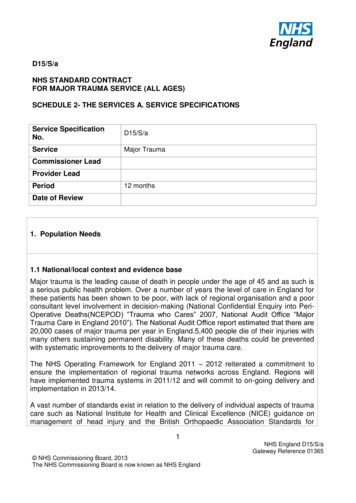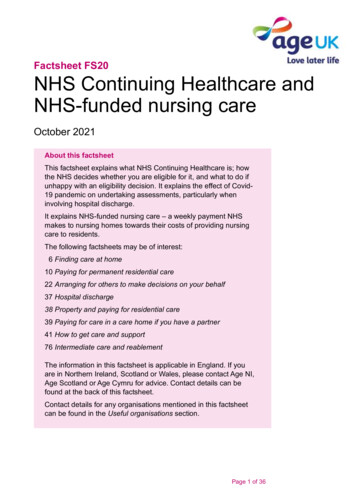
Transcription
D15/S/aNHS STANDARD CONTRACTFOR MAJOR TRAUMA SERVICE (ALL AGES)SCHEDULE 2- THE SERVICES A. SERVICE SPECIFICATIONSService SpecificationNo.D15/S/aServiceMajor TraumaCommissioner LeadProvider LeadPeriod12 monthsDate of Review1. Population Needs1.1 National/local context and evidence baseMajor trauma is the leading cause of death in people under the age of 45 and as such isa serious public health problem. Over a number of years the level of care in England forthese patients has been shown to be poor, with lack of regional organisation and a poorconsultant level involvement in decision-making (National Confidential Enquiry into PeriOperative Deaths(NCEPOD) “Trauma who Cares” 2007, National Audit Office “MajorTrauma Care in England 2010”). The National Audit Office report estimated that there are20,000 cases of major trauma per year in England.5,400 people die of their injuries withmany others sustaining permanent disability. Many of these deaths could be preventedwith systematic improvements to the delivery of major trauma care.The NHS Operating Framework for England 2011 – 2012 reiterated a commitment toensure the implementation of regional trauma networks across England. Regions willhave implemented trauma systems in 2011/12 and will commit to on-going delivery andimplementation in 2013/14.A vast number of standards exist in relation to the delivery of individual aspects of traumacare such as National Institute for Health and Clinical Excellence (NICE) guidance onmanagement of head injury and the British Orthopaedic Association Standards for1NHS England D15/S/aGateway Reference 01365 NHS Commissioning Board, 2013The NHS Commissioning Board is now known as NHS England
Trauma (BOAST) guidelines for open fractures and pelvic fractures. A number of these,together with additional expert opinion, are been assimilated into aperformance management framework which will be based on a dashboard and aquarterly report which will drive the management of care quality within the networks.The NHS Clinical Advisory Group (CAG) provides recommendations on theregionalisation of trauma care, setting out service standards for the provision and deliveryof major trauma care. It states that regionalising trauma services involves developingInclusive Trauma Systems through Trauma Networks, which include all providers ofTrauma Care, from pre-hospital care through to rehabilitation1Seriously injured adults and children2 are described as having suffered from majortrauma. This is measured on a scale known as the Injury Severity Score (ISS) whichscores injuries from 1 to 75, the latter being the most serious. Patients who have anISS 15 are defined as having suffered from major trauma. In addition, patients with anISS of 9-15 have moderately severe trauma.It is not possible to determine the ISS at the time of injury as it requires a full diagnosticassessment and often surgical intervention in hospital. For these reasons a system oftriage is used which identifies those patients who are most likely to have had majortrauma, these patients are referred to as ”candidate major trauma” patients .Pre-hospitalemergency services have developed major trauma decision protocols for use by crews todetermine the most appropriate destination of injured patients. Those with potential majortrauma injuries (“candidate” major trauma patients) will be taken directly to a MajorTrauma Centre (MTC) where travel times allow, otherwise to the nearest Trauma Unit(TU) for rapid stabilisation and transfer to the MTC where those injuries exceed thecapability of a Trauma Unit and in line with local protocols.The scope of this specification relates to patients who have been triaged as major traumapatients (adult or child) with an ISS 8 using a major trauma triage tool and treated in aMajor Trauma Centre. A number of these patients will be found to haveISS 15 and a further cohort an ISS of 9 - 15. The exact score will not be known until thedata is submitted at a later stage to the Trauma Audit Research Network (TARN)database for ISS coding.Evidence Base and Key Publications 12Regional Networks for Major Trauma NHS Clinical Advisory Groups onsPolicyAndGuidance/DH 122738Regional Networks for Major Trauma NHS Clinical Advisory Groups ReportThroughout this specification we will use the phrase ‘patients’ this is intended to mean both adults and children2NHS England D15/S/aGateway Reference 01365 NHS Commissioning Board, 2013The NHS Commissioning Board is now known as NHS England
2. Outcomes2.1 NHS Outcomes Framework Domains & nting people from dying prematurelyEnhancing quality of life for people with longterm conditionsHelping people to recover from episodes of illhealth or following injuryEnsuring people have a positive experience ofcareTreating and caring for people in safeenvironment and protecting them fromavoidable harm 3.1 Aims and objectives of serviceThe aim of the service is to provide care to major trauma patients (ISS 8) who aredelivered to the Major Trauma Centre. The Major Trauma Centre has all the servicesavailable to receive and manage seriously injured adults and/or children. Patients whohave been incorrectly triaged or have self- presented at a Trauma Unit (TU) with seriousinjury which exceeds the resources and capability of the TU will be rapidly transferred to aMTC. In addition, some patients will need treatment in the MTC (for example for pelvicfracture surgery) which will require transfer in within the first 2 days following injury.There are three types of MTC – those that treat only adults, those that treat only childrenand those who can treat both adults and children. The service is designed to deliver highquality specialist care to patients of all ages starting from admission to the relevant MTC,with full assessment and diagnostics in the emergency department. This may be followedby operative treatment and an episode in the critical care unit and ward. Rehabilitation isrequired for a number for patients, and this rehabilitation will start in the MTC and continuethrough specialist rehabilitation units or locally through a variety of commissionedproviders defined in the network. This specification covers the period of treatment within3NHS England D15/S/aGateway Reference 01365 NHS Commissioning Board, 2013The NHS Commissioning Board is now known as NHS England
the MTC until discharge or transfer to another provider.Overall the service aims are, to provide a comprehensive system of specialist care forpeople who have suffered serious injury (major trauma) through the delivery of a regionaltrauma network. The components of this are: A system of initial triage to enable conveyance by the local ambulance service to themost appropriate destination according to agreed criteria. One or more Major Trauma Centres (MTCs) linked into local Trauma Units (TUs),working with Local Emergency Hospitals (LEH), local general rehabilitation servicesand Specialist Rehabilitation (SR) providers. Services for children including specialist rehabilitation will be provided at a children’sMTC or in a combined adult/children’s MTC. To deliver a system based on a pathway of care from the pre-hospital phaseincluding rehabilitation and a return to socio-economic functioning. To ensure the quality of the system is monitored and subject to a process ofcontinuous quality improvement. To reduce avoidable deaths in the population of patients who would previously havedied of their injuries. To reduce avoidable deaths and life limiting injuries through an injury preventionprogramme To improve the functionality, health and psychological wellbeing, in those patientswho survive their traumatic injuries; increasing their quality of life3.2 Service description/care pathwayService Description:Service DeliveryMajor Trauma care is delivered through an inclusive Trauma Network delivery model. ATrauma Network includes all providers of trauma care, particularly: pre-hospital services,other hospitals receiving acute trauma admissions (Trauma Units), and rehabilitationservices. The network has appropriate links to the social care and thevoluntary/community sector.Major Trauma Centres (MTCs) (covered by this specification) sit at the heart of TraumaNetworks as the centres of excellence providing multi-specialty hospital care to seriouslyinjured patients, optimised for the provision of trauma care. They are the focus of theTrauma Network and manage all types of trauma but specifically have the lead formanaging candidate major trauma patients, providing consultant-level care and access totertiary and specialised level services. Within the Trauma Network the MTC: Is optimised for the definitive care of injured patients. In particular it has an active,effective trauma Quality Improvement programme. It also provides specialistearly/hyper acute rehabilitation as well as a managed transition to rehabilitation andthe community. Takes responsibility for the care of all patients with Major Trauma in the area coveredby the Network. It also supports the Quality Improvement programmes of other4NHS England D15/S/aGateway Reference 01365 NHS Commissioning Board, 2013The NHS Commissioning Board is now known as NHS England
hospitals in its Network.It provides all the major specialist services relevant to the care of major trauma, i.e.general, emergency medicine, vascular, orthopaedic, plastic, spinal, maxillofacial,cardiothoracic and neurological surgery, specialist early/hyper acute rehabilitation andinterventional radiology, along with appropriate supporting services, such as critical care.The whole specialised pathway of care for major trauma patients is described in Figure 1See Appendix 1The elements which will be commissioned under the contract, relate to those describedbelow. Under the contract MTCs will be required to work with partners (detailed inAppendix 2) such as the ambulance service, Trauma Units, Local Emergency Hospitalsand specialist and general rehabilitation providers to ensure delivery of the whole pathwayincluding the specialised component described here.As part of this pathway, the MTCs themselves deliver services that can be described asacute care and surgery, on-going care and reconstruction and acute/early phaserehabilitation.Due to the very nature of major trauma care and its system, network and interspecialtydelivery model; there are also a number of interdependent services and specialtiesrequired to work in partnership to deliver seamless and high quality care, these aredescribed in section 2.5.Services are to be delivered in line with the standards of the Regional Networks for MajorTrauma NHS Clinical Advisory Groups Report (2010).When treating children, the service will additionally follow the standards andcriteria outlined in the Specification for Children’s Services (attached as Annex1 to this Specification).Care PathwayReferralTrauma Networks will comprise one or more MTCs linked to a number of TUs. Patientswill be triaged to a MTC if they trigger tool and secondary transfer protocol; these maydiffer across regions and systems. MTCs will have a policy of automatic acceptance forpatients requiring MTC care from within the network who have been correctly triaged toa TU, under triaged or self- presented. Networks will work together collaborativelyensuring patients have seamless access to care and transfer back to their localityhospital or host TU when medically fit.Emergency Care5NHS England D15/S/aGateway Reference 01365 NHS Commissioning Board, 2013The NHS Commissioning Board is now known as NHS England
Major Trauma Centre (MTC)A MTC (adult, child or combined) has all the facilities and specialties required to be ableto treat patients with any type of injury in any combination. Patients who have ISS greaterthan 8 and are treated in a MTC are covered by this specification. Examples of suchpatients, are patients who have suffered traumatic amputation of one or more limbs,patients with a serious head injury and patients who have suffered a number of injures(known as polytrauma) such as a combination of abdominal and chest injuries. Elementsof the service to manage these patients will include:Emergency Care and Surgery: 24/7 consultant available on site to lead the trauma team The trauma team should be appropriately trained and competent to deliver their role(Appendix 6) Trauma team present 24 hours a day for immediate reception of the patient; Ability to undertake resuscitative thoracotomy in the emergency department (ED); A massive haemorrhage protocol in place for patients with severe blood loss whichincludes the administration of tranexamic acid within 3 hours of injury, and transfusionspecialist advice should be available 24 hours a day; 24/7 immediate availability of fully staffed operating theatres; All emergency operative interventions performed within the first 24 hours shouldhave evidence of consultant involvement, and consultant presence in the operatingroom for life- or limb-threatening injuries. A consultant will be involved in surgicaldecision making; Emergency trauma surgery will be undertaken or directly supervisedby consultants (Annex 2);There will be a network protocol in place and operational atthe MTC for assessing the whole spine in Major Trauma patients; Consultants available on site within 30 minutes when required; Neurosurgery; Spinaland spinal cord surgery; Vascular surgery; General surgery (adult or child); Traumaand Orthopaedic surgery; Cardiothoracic surgery; Plastic surgery; Maxillofacialsurgery; Ear nose and throat surgery; Anaesthetics; Interventional radiology;Intensive care. For Children's MTC, where the incidence of major trauma overnight is demonstrablylow, a consultant should be immediately available on site to lead the trauma teambetween 8am to midnight. They should be available on site within 30 minutes ofreceiving an alert call at all other times.Diagnostics and Radiology Immediate (defined as within a maximum of 60 minutes, ideally within 30 minutes)access to computerised tomography (CT) scanning and appropriate reportingwithin 60 minutes of scan;Availability of interventional radiology within 60 minutes of referral.On-going Care and Reconstruction Immediate access to critical care or high dependency care (adult or paediatric) when6NHS England D15/S/aGateway Reference 01365 NHS Commissioning Board, 2013The NHS Commissioning Board is now known as NHS England
requiredA defined team to manage on-going patient care, including a key worker (alsoreferred to as trauma and rehabilitation co-ordinator) to support patients through thepathway and into rehabilitation. Model for the key worker may vary in centres.Specialist nursing and allied health professional trauma roles.Access to cross speciality supporting services which will include pain management,rehabilitation medicine (which usually includes management of disturbed behaviour)and neuropsychology and neuropsychiatry.A defined ward for major trauma patients.A ward environment suitable for people with disability to practice and maintain theiractivities, specifically having enough space for people to get up and dress with someprivacy, having toilets and baths/showers safely accessible for assisted orindependent use by patients, and having facilities to allow the making of snacks andhot drinks.A nursing team in the ward, who are able to facilitate practice of and independence infunctional activities by the patient, and undertake activities with the patient asadvised, by the rehabilitation team.Early/Hyper Acute Phase Rehabilitation 3A defined service for early/hyper acute trauma rehabilitation which meets the needsof patients with ISS 8.Review within 3 calendar days by a Rehabilitation Medicine consultant or alternativeconsultant with skills and competencies in rehabilitation3 (allowing up to 4 calendardays if seriously at risk of dying or if review prior to 4 calendar days is not clinicallypossible), with the output being an initial formulation (analysis of relevant factors) andplan to complete and inform the initial rehabilitation prescription.The prescription for rehabilitation reflects the assessment of the physical, functional,vocational, educational, cognitive, psychological and social rehabilitation needs of apatient.An initial assessment by the relevant members of a specialist rehabilitation team(including nurses) to add to the medical review. The output of the above two actions will be that all patients covered by thisspecification (without exception) have an initial rehabilitation prescription within2-4 calendar days of presentation. Note that the prescription may identify nofurther need for rehabilitation, or may simply recommend monitoring or mayrequire full active engagement of the wider rehabilitation team. All patients to receive early phase rehabilitation as indicated by theRehabilitation prescription, and all other actions identified in the rehabilitationprescription to be undertaken; if action or input cannot be delivered, the reasonshould be recorded and intervening action to be undertaken. All patients needing rehabilitation input or monitoring to be under the care of aConsultant-delivered team that includes rehabilitation nurses, allied healthprofessionals and a consultant in rehabilitation medicine or alternativeFor example, for children and elderly patients with significant co-morbidities7NHS England D15/S/aGateway Reference 01365 NHS Commissioning Board, 2013The NHS Commissioning Board is now known as NHS England
consultant with skills and competencies in rehabilitation. This team will meetweekly to discuss all patients within the scope of this specification in the MTC(Including those in Intensive Care Units (ICU) and ward areas); a specialitytrainee registrar (StR) at St4 or above in rehabilitation may deputise for aconsultant on occasion but a consultant should attend over 80% of meetingsand continue to provide supervision and support to the team.PsychiatryPatients who suffer Major Trauma due to self-harm must have access to acutepsychiatric services in Major Trauma Centres with a 24/7 on-call consultantpsychiatrist/child psychiatrist & liaison mental health service available on site to providetimely advice and support. Where necessary, access to a neuropsychiatric assessmentshould be available, Staff on major adult or paediatric trauma units should be providedwith training to help them identify the common mental health disorders which occur inresponse to major trauma, and to manage the related risk behaviours. This serviceshould be available with equity for adults and childrenBurnsWhere burn injury occurs in isolation or alongside less serious injury then patients shouldbe transported in accordance with local pre-hospital triage protocols. Ideally this wouldbe to an Emergency Department associated with a Specialised Burn Service of theappropriate level. This would ensure that burns expertise is available on site and thusreduce the potential need for a secondary transfer. Where this is not possible, transfer toan appropriate specialised burn service should occur as early as possible after injury.Network Delivery: MTCs will provide clinical advice to other providers within the network. This willinclude; in pre-hospital stage and whilst patients are awaiting transfer to the MTC fordefinitive treatment or following acute care when the patient is discharged to on-goingspecialised or local rehabilitation services. For major trauma patients triaged to a TU (due to local geographical or triage toolarrangements) requiring secondary transfer, this will occur within 48 hours of referral.For those patients that require definitive care at the MTC and those with a serioushead injury, they will be transferred to the MTC without delay. MTC will commit to being actively engaged and contributing to the Trauma Network,particularly in operational requirements, training, governance and audit. Deliver care and access to treatment in line with locally agreed network protocols andguidelines.MTCs will deliver/provide the roles, functions and responsibilities of leading a network asset out by the Operational Delivery Network guidance and according to the operationaldelivery network service specification.Discharge planning, Continuing Care and Rehabilitation (from the acute service).8NHS England D15/S/aGateway Reference 01365 NHS Commissioning Board, 2013The NHS Commissioning Board is now known as NHS England
CommunicationThere will be effective communication between all those responsible for the patient’scare, the patient and where appropriate their family and other carers.Patients will be provided with a full range of condition-specific information inappropriate formats.ODN for Major Trauma will take an active role in supporting network-widecommunication.Audit, Data Management, Governance and Quality Improvement Full data submission to TARN within 25 calendar days following a patient’sdischargeMTC will be responsible for drawing down from TARN their report and ensuring theISS is confirmed within the Commissioning data set as per the informationalgorithm for Major Trauma (described in appendix 3)MTCs will be responsibility for their clinical governance, and collaborate in a qualityimprovement programme using TARN data as its basis as members of theNetwork.Networks will meet regularly to examine performance through formal governanceprocesses. Performance improvement will be undertaken through regular mortality andmorbidity meetings which will generate action plans for improvement.Oversight of the network will be undertaken according to local structures and processes,MTCs may be responsible for the management of the operational network in the futureWhere an MTC has key services located across more than one site, an operational planwill be available that describes how major trauma patients are treated and patientoutcomes delivered.The MTC takes responsibility for the care of all patients referred with major trauma in thearea covered by the Network; as defined by local protocols and capabilities of localTrauma Units and transfer arrangements to a MTC for under triage and secondarytransfer protocols. It also supports the Quality Improvement programmes of otherhospitals in its NetworkEducation and TrainingSee APPENDIX 6Referral processes and sources9NHS England D15/S/aGateway Reference 01365 NHS Commissioning Board, 2013The NHS Commissioning Board is now known as NHS England
The major trauma patient pathway is an emergency pathway with patients triagedthrough the local ambulance service or referred on by TUs. The nearest MTC may be ina network which is in a different SHA cluster to that from where the incident occurred.Cross-boundary discussions need to take place to ensure patients pathways areclarified in this situation.Some patients who are triaged into a MTC may require immediate onward referral.These patients include burns patients and those with spinal cord injury. The appropriateguidelines for each condition will be used in this situation.Discharge criteria and planningPatients may be discharged to a number of on-going destinations. A number will bedischarged home from the MTC following assessment in the emergency department orafter a period of in-patient treatment. Others will require on-going management and willbe transferred to an appropriate healthcare provider within the same or a differentnetwork.A few patients will be transferred rapidly for further acute specialist care – this includeschildren, patients with severe burns, spinal cord injury, those requiring reconstructivesurgery and children with head injuries requiring a paediatric neurosciences centre.Some patients will require admission to specialist rehabilitation centre such as those forneurological rehabilitation. It may also include onward referral for amputee rehabilitation,equipment and prosthetics and to local general rehabilitation services.Patient-Centred ServicesAcross networks there will be a focus on delivery of patient centred services whichconsider all of the health and well-being needs of people who have sustainedtraumatic injuries. The important role of family and friends will be acknowledged andactively supported. Services will ensure; Routine involvement of the patient and their family/carers – including early andrepeated case meetings – wherever possible, to discuss all care and injurymanagement decisions, including coordination and planning of interventions. A ”patient-welfare-centred” framework that permeates all stages of care for traumapatients. This will start with training of all medical and non-medical staff regarding theethos of such a service and how it relates to personnel infrastructure. All patients will have a patient held record which continues their clinical informationand treatment plan from admission through to specialised or local rehabilitation(supported by the prescription for rehabilitation). In the case of paediatrics, this canbe an age related hand held record for the patient and a full hand held record for theparent or career. A framework where all aspects of patients health, well-being, medical and non-medical needs are overseen by one team, and specifically coordinated byone member of this team. Consideration of the impact of the physical environment and care processes (wardrounds, discussions about medical and non-medical requirements) on patients, withparamount importance given to promotion of patient privacy, dignity and10NHS England D15/S/aGateway Reference 01365 NHS Commissioning Board, 2013The NHS Commissioning Board is now known as NHS England
independence in functional activities.Evaluation of services must go beyond mortality rates and focus more on assessingpatients well-being in the hospital environment and achievement of optimum functionin the context of their personal preferences. A holistic trauma care framework whichincludes parents/family/carer in service design, to include: Flexible visiting hours (according to local hospital protocols)Addressing transport and accommodation needs of Parents/family/ carer (e.g.providing car parking, kitchen facilities and accommodation for close relativeswho have to travel a reasonable distance to the Trauma Centre. Making available information for support services of relevant voluntary sectororganisations in individual care plans from the outset which may include accessto counselling, psychological and pastoral service for patients and familymembers. Providing access to patient and carer support groups with other patients, carers,parents who have been through the major trauma pathway. Coordination of medical, nursing and rehabilitation packages of care. The Trauma and Rehabilitation team will have understanding of thepsychological and social impact of disfigurement and impact of traumaticinjuries sustained Early involvement of continuing care or social care where assessments forfunding are required to facilitate onward referral and placement. Patient, parent and carer information to describe patient pathway and likelytreatment and recovery process (e.g. behaviour). This will also include facilitiesand maps for any likely future discharge destination within the networkGeneral Paediatric careWhen treating children, the Service will additionally follow the standards and criteriaoutlined in the Specification for Children’s’ Services (attached as Annex 1 to thisSpecification)Operational Deliver Network (ODN)MTCs will either be the host or network organisation part of an operational deliverynetworks, the service standards, roles are responsibilities are defined within the servicespecification for Trauma Operational Delivery Networks (ODNs). ODNs will ensure qualitystandards and networked patient pathways are in place. They will focus on an operationalrole, supporting the activity of Provider Trusts in service delivery, improvement anddelivery of a commissioned pathway, with a key focus on the quality and equity of accessto service provision. This will allow for more local determination, innovation and efficiencyacross the pathway. ODNs support the delivery of ‘Right Care’ principles by incentivizing asystem to manage the right patient in the right place.3.3 Population coveredThe service outlined in this specification is for patients ordinarily resident in England*; orotherwise the commissioning responsibility of the NHS in England (as defined in Who11NHS England D15/S/aGateway Reference 01365 NHS Commissioning Board, 2013The NHS Commissioning Board is now known as NHS England
Pays?: Establishing the responsible commissioner andother Department of Health guidance relating to patients entitled to NHS care or exemptfrom charges).*Note: for the purposes of commissioning health services, this EXCLUDES patientswho, whilst resident in England, are registered with a General Practitioner (GP) Practicein Wales, but INCLUDES patients resident in Wales who are registered with a GPPractice in England.Specifically, this service is for adults and children with major trauma injuries (as defined byISS 8) requiring specialised invention and management in a Major Trauma Centre, asoutlined in this specification.3.4 Any acceptance and exclusion criteria and thresholdsAcceptance CriteriaThe MTC will accept patients who have been triaged using local triage tool and secondarytransfer protocols and arrive by direct primary transfer, emergency secondary transferfrom a TU or self-presentation. Patients within the network who require secondarytransfer because of under-triage, self-presentation or because initial travel times tospecialist MTC are greater than the agreed network protocols, w
and Specialist Rehabilitation (SR) providers. Services for children including specialist rehabilitation will be provided at a children's MTC or in a combined adult/children's MTC. To deliver a system based on a pathway of care from the pre-hospital phase including rehabilitation and a return to socio-economic functioning.











